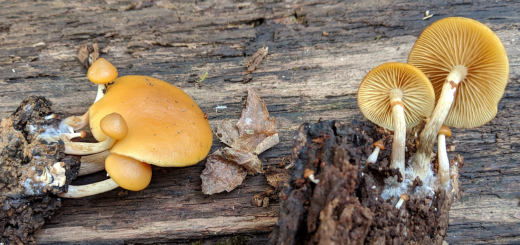#083: Hypomyces lactifluorum: The Lobster Mushroom
Lobster Mushrooms are the strangest mushrooms you will ever eat. Yes, these mushrooms are even stranger than edible stinkhorns, which are foul-smelling and sometimes gelatinous. What makes Lobster Mushrooms truly weird is that they are actually a fungus (Hypomyces lactifluorum) growing on top of a mushroom. It is this parasitic relationship that gives Lobster Mushrooms their shape and makes them edible.
Lobster Mushrooms are aptly named: they have a bright, orange-red, crunchy exterior and a white, firm interior. Slice one in half and it looks remarkably like a cooked lobster (although it probably isn’t shaped like a lobster). The shape of a lobster mushroom varies from roughly toadstool-shaped (somewhat like a short, stocky umbrella) to a roundish, lobed blob. H. lactifluorum grows only on members of the genera Russula and Lactarius, which have a central stipe, circular cap, and gills. The mushrooms are trying to grow into that shape, but they are often prevented from doing so by H. lactifluorum. The more well-defined Lobster Mushrooms look a little like someone has simply spray painted the mushroom orange. In these cases, the features are usually somewhat muted: the gills are rarely more than bumps underneath the cap. Other times, especially as the mushroom ages, H. lactifluorum severely disfigures the mushroom, rendering it unrecognizable as an agaric.
The outer surface of a Lobster Mushroom is orange to orange-red, hard, and finely pimply. When H. lactifluorum attacks a mushroom, it quickly envelops the entire mushroom, so the surface of a Lobster Mushroom is uniform and created by the parasite. A tiny bit of the original mushroom may be visible just at the mushroom’s base. If you were to cut open a Lobster Mushroom and examine it closely, you would notice small, white, flask-shaped regions just below the outer orange layer. These structures are called perithecia and are where H. lactifluorum produces sexual spores. The asci (tube-shaped cells that produce sexual spores called ascospores) line the inner surface of the perithecium and release their spores via a small pore at the surface. Each tiny bump on the surface corresponds to a perithecium pore. The spores themselves are shaped like a spindle, feature many small warts, are colorless, and are divided in half by a cell wall.
If you’ve been keeping up with Fungus Fact Friday, the perithecium structure should sound familiar. H. lactifluorum, Dead Man’s Fingers (Xylaria polymorpha), Cordyceps militaris, and Biscogniauxia atropunctata all form perithecia. Not surprisingly, all of these mushrooms belong to the phylum Ascomycota and the class Sordariomycetes. Within this class, H. lactifluorum belongs to the order Hypocreales and family Hypocreaceae.
The inner surface of a Lobster Mushroom is firm, white, and made by the host mushroom. Depending on the species of mushroom being parasitized, the interior may be fairly crumbly or ooze a latex. Because H. lactifluorum obscures the mushroom’s features, it is impossible to identify the host mushroom without DNA analysis. You can make a good guess by looking at the russulas and lacteriuses fruiting nearby (there are usually some uninfected mushrooms around), but you can never by 100% sure that those represent the same mushroom.
This raises an interesting question about edibility. H. lactifluorum is known to be edible, but you can never really be completely sure of the mushroom host. One of the most common hosts is Russula brevipes, which is edible (but not especially good). However, many Lactarius species are poisonous or too peppery for most people to eat. Luckily for the mushroom hunter, H. lactifluorum is either an exceptional taxonomist or produces compounds that neutralize the host mushroom’s toxins. Thanks to the parasite, there has never been a recorded case of Lobster Mushroom poisoning. Additionally, H. lactifluorum improves the flavor of its host mushroom. R. brevipes, which normally has a mediocre flavor, has a great flavor when parasitized by H. lactiflorum. Similarly, the unbearably peppery flavor of Lactarius piperatus is greatly dulled down in Lobster Mushrooms. Lobster Mushrooms usually have a mild flavor, but are sometimes slightly peppery due to the host mushroom. Some people say that Lobster Mushrooms taste like seafood, but I suspect that is a mental trick resulting from the name “Lobster Mushroom.”
Lobster Mushrooms, like many mushrooms, are extremely versatile in cooking. They readily pick up the flavors in a dish and can easily complement all sorts of recipes. However, you should not cook them for long, as they will lose some of their own flavor. Lobster Mushrooms are great dyes and will impart a red color to your food. Their crunchy texture and unique color go well in stir fry, soups, stews, and similar dishes. They can also be sautéed or baked. Lobster Mushrooms are often used in seafood dishes, where they are added shortly before the dish is served.
See Further:
http://botit.botany.wisc.edu/toms_fungi/aug2001.html
http://www.mykoweb.com/CAF/species/Hypomyces_lactifluorum.html
http://www.mushroomexpert.com/hypomyces_lactifluorum.html
http://mdc.mo.gov/discover-nature/field-guide/lobster-mushroom
http://www.oregonmushrooms.com/mushrooms-information/lobster-mushrooms/lobster-mushrooms.html
http://www.lobster-mushrooms.com/








![#011: Characteristics of Kingdom Fungi [Archived]](https://www.fungusfactfriday.com/wp-content/themes/hueman/assets/front/img/thumb-small-empty.png)
